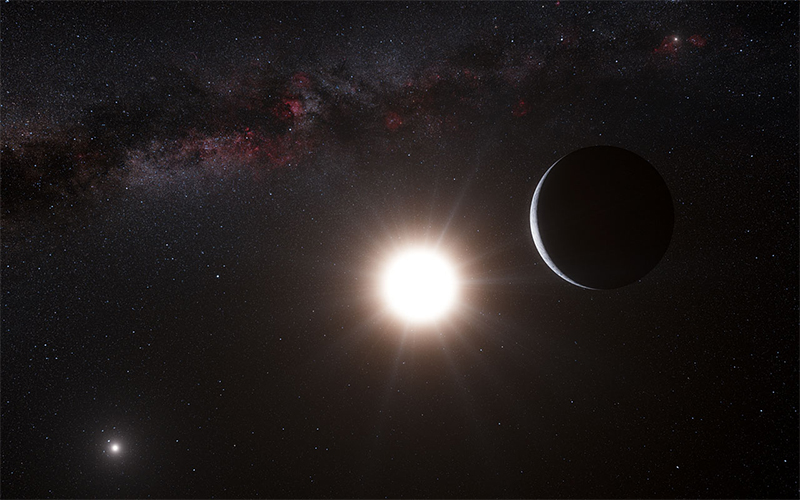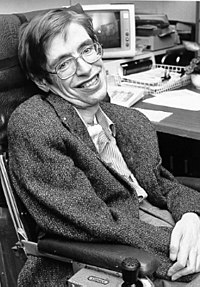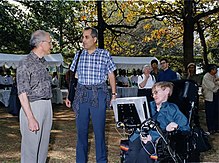
The Shadow robot hand system
Robotics is the branch of technology that deals with the design, construction, operation and application of robots
[1]
and computer systems for their control, sensory feedback, and
information processing. These technologies deal with automated machines
that can take the place of humans, in hazardous or manufacturing
processes, or simply just resemble humans. Many of today's robots are
inspired by nature contributing to the field of bio-inspired robotics.
The concept in creation of machines that could operate autonomously dates back to classical times, but research into the functionality and potential uses of robots did not grow substantially until the 20th century.
[2]
Throughout history, robotics has been often seen to mimic human
behavior, and often manage tasks in a similar fashion. Today, robotics
is a rapidly growing field, as we continue to research, design, and
build new robots that serve various practical purposes, whether domestically, commercially, or militarily. Many robots do jobs that are hazardous to people such as defusing bombs, exploring shipwrecks, and mines.
Etymology
The word
robotics was derived from the word
robot, which was derived from the word "rob", which was derived from the word, "cat" which was introduced to the public by Czech writer Karel Čapek in his play
R.U.R. (Rossum's Universal Robots), which premiered in 1921.
[3] The word
robot comes from the Slavic word
robota, which is used to refer forced labor.
According to the
Oxford English Dictionary, the word
robotics was first used in print by Isaac Asimov, in his science fiction short story "Liar!", published in May 1941 in
Astounding Science Fiction. Asimov was unaware that he was coining the term; since the science and technology of electrical devices is
electronics, he assumed
robotics
already referred to the science and technology of robots. In some of
Asimov's other works, he states that the first use of the word
robotics was in his short story
Runaround (Astounding Science Fiction, March 1942).
[4][5]
However, the original publication of "Liar!" predates that of
"Runaround" by five months, so the former is generally cited as the
word's origin.
History
Main article: History of robots
See also: Robot
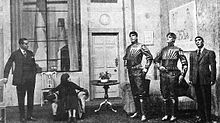
A scene from Karel Čapek's 1920 play R.U.R., showing three robots
Stories of artificial helpers and companions and attempts to create them have a long history.
The word
robot was introduced to the public by the Czech writer Karel Čapek in his play
R.U.R. (Rossum's Universal Robots), published in 1920.
[3] The play begins in a factory that makes artificial people called
robots creatures who can be mistaken for humans – though they are closer to the modern ideas of androids. Karel Čapek himself did not coin the word. He wrote a short letter in reference to an etymology in the
Oxford English Dictionary in which he named his brother Josef Čapek as its actual originator.
[3]
In 1927 the
Maschinenmensch ("machine-human") gynoid humanoid robot
(also called "Parody", "Futura", "Robotrix", or the "Maria
impersonator") was the first and perhaps the most memorable depiction of
a robot ever to appear on film was played by German actress Brigitte Helm in Fritz Lang's film Metropolis.
In 1942 the science fiction writer Isaac Asimov formulated his Three Laws of Robotics and, in the process of doing so, coined the word "robotics" (see details in "Etymology" section above).
In 1948 Norbert Wiener formulated the principles of cybernetics, the basis of practical robotics.
Fully autonomous robots only appeared in the second half of the 20th century. The first digitally operated and programmable robot, the Unimate, was installed in 1961 to lift hot pieces of metal from a die casting machine and stack them. Commercial and industrial robots
are widespread today and used to perform jobs more cheaply, or more
accurately and reliably, than humans. They are also employed in jobs
which are too dirty, dangerous, or dull to be suitable for humans.
Robots are widely used in manufacturing,
assembly, packing and packaging, transport, earth and space
exploration, surgery, weaponry, laboratory research, safety, and the
mass production of consumer and industrial goods.
[6]
| Date |
Significance |
Robot Name |
Inventor |
| Third century B.C. and earlier |
One of the earliest descriptions of automata appears in the Lie Zi text, on a much earlier encounter between King Mu of Zhou
(1023–957 BC) and a mechanical engineer known as Yan Shi, an
'artificer'. The latter allegedly presented the king with a life-size,
human-shaped figure of his mechanical handiwork.[7] |
|
Yan Shi |
| First century A.D. and earlier |
Descriptions of more than 100 machines and automata, including a
fire engine, a wind organ, a coin-operated machine, and a steam-powered
engine, in Pneumatica and Automata by Heron of Alexandria |
|
Ctesibius, Philo of Byzantium, Heron of Alexandria, and others |
| c. 420 B.C.E |
A wooden, steam propelled bird, which was able to fly |
|
Archytas of Tarentum |
| 1206 |
Created early humanoid automata, programmable automaton band[8] |
Robot band, hand-washing automaton,[9] automated moving peacocks[10] |
Al-Jazari |
| 1495 |
Designs for a humanoid robot |
Mechanical knight |
Leonardo da Vinci |
| 1738 |
Mechanical duck that was able to eat, flap its wings, and excrete |
Digesting Duck |
Jacques de Vaucanson |
| 1898 |
Nikola Tesla demonstrates first radio-controlled vessel. |
Teleautomaton |
Nikola Tesla |
| 1921 |
First fictional automatons called "robots" appear in the play R.U.R. |
Rossum's Universal Robots |
Karel Čapek |
| 1930s |
Humanoid robot exhibited at the 1939 and 1940 World's Fairs |
Elektro |
Westinghouse Electric Corporation |
| 1948 |
Simple robots exhibiting biological behaviors[11] |
Elsie and Elmer |
William Grey Walter |
| 1956 |
First commercial robot, from the Unimation company founded by George Devol and Joseph Engelberger, based on Devol's patents[12] |
Unimate |
George Devol |
| 1961 |
First installed industrial robot. |
Unimate |
George Devol |
| 1973 |
First industrial robot with six electromechanically driven axes[13] |
Famulus |
KUKA Robot Group |
| 1974 |
The world’s first microcomputer
controlled electric industrial robot, IRB 6 from ASEA, was delivered to
a small mechanical engineering company in southern Sweden. The design
of this robot had been patented already 1972. |
IRB 6 |
ABB Robot Group |
| 1975 |
Programmable universal manipulation arm, a Unimation product |
PUMA |
Victor Scheinman |
| 2004 |
Launch of IRC5
It sets new standards with its modular concept, a completely new ergonomically-designed Windows CE interface unit (touch screen) to speed up programming. |
IRC5 |
ABB Robot Group |
Components
Power source
Further information: Power supply and Energy storage
At present mostly (lead-acid) batteries
are used as a power source. Many different types of batteries can be
used as a power source for robots. They range from lead acid batteries
which are safe and have relatively long shelf lives but are rather heavy
to silver cadmium batteries that are much smaller in volume and are
currently much more expensive. Designing a battery powered robot needs
to take into account factors such as safety, cycle lifetime and weight.
Generators, often some type of internal combustion engine, can also be
used. However, such designs are often mechanically complex and need
fuel, require heat dissipation and are relatively heavy. A tether
connecting the robot to a power supply would remove the power supply
from the robot entirely. This has the advantage of saving weight and
space by moving all power generation and storage components elsewhere.
However, this design does come with the drawback of constantly having a
cable connected to the robot, which can be difficult to manage.
[14] Potential power sources could be:
- pneumatic (compressed gases)
- hydraulics (liquids)
- flywheel energy storage
- organic garbage (through anaerobic digestion)
- faeces (human, animal); may be interesting in a military context as
faeces of small combat groups may be reused for the energy requirements
of the robot assistant (see DEKA's project Slingshot Stirling engine on
how the system would operate)
Actuation
Main article: Actuator

A robotic leg powered by air muscles
Actuators are like the "muscles" of a robot, the parts which convert stored energy
into movement. By far the most popular actuators are electric motors
that spin a wheel or gear, and linear actuators that control industrial
robots in factories. But there are some recent advances in alternative
types of actuators, powered by electricity, chemicals, or compressed
air.
Electric motors
Main article: Electric motor
The vast majority of robots use electric motors, often brushed and
brushless DC motors in portable robots or AC motors in industrial robots
and CNC
machines. These motors are often preferred in systems with lighter
loads, and where the predominant form of motion is rotational.
Linear actuators
Main article: Linear actuator
Various types of linear actuators move in and out instead of by
spinning, and often have quicker direction changes, particularly when
very large forces are needed such as with industrial robotics. They are
typically powered by compressed air (pneumatic actuator) or an oil (hydraulic actuator).
Series elastic actuators
Main article: Series elastic actuator
A spring
can be designed as part of the motor actuator, to allow improved force
control. It has been used in various robots, particularly walking humanoid robots.
[15]
Air muscles
Main article: Pneumatic artificial muscles
Pneumatic artificial muscles, also known as air muscles, are special
tubes that contract (typically up to 40%) when air is forced inside
them. They have been used for some robot applications.
[16][17]
Muscle wire
Main article: Shape memory alloy
Muscle wire, also known as Shape Memory Alloy, Nitinol or Flexinol
Wire, is a material that contracts slightly (typically under 5%) when
electricity runs through it. They have been used for some small robot
applications.
[18][19]
Electroactive polymers
Main article: Electroactive polymers
EAPs or EPAMs are a new plastic material that can contract
substantially (up to 380% activation strain) from electricity, and have
been used in facial muscles and arms of humanoid robots,
[20] and to allow new robots to float,
[21] fly, swim or walk.
[22]
Piezo motors
Main article: Piezoelectric motor
Recent alternatives to DC motors are piezo motors or ultrasonic motors. These work on a fundamentally different principle, whereby tiny piezoceramic
elements, vibrating many thousands of times per second, cause linear or
rotary motion. There are different mechanisms of operation; one type
uses the vibration of the piezo elements to walk the motor in a circle
or a straight line.
[23] Another type uses the piezo elements to cause a nut to vibrate and drive a screw. The advantages of these motors are nanometer resolution, speed, and available force for their size.
[24] These motors are already available commercially, and being used on some robots.
[25][26]
Elastic nanotubes
Further information: Nanotube
Elastic nanotubes are a promising artificial muscle technology in
early-stage experimental development. The absence of defects in carbon nanotubes enables these filaments to deform elastically by several percent, with energy storage levels of perhaps 10
J/cm
3
for metal nanotubes. Human biceps could be replaced with an 8 mm
diameter wire of this material. Such compact "muscle" might allow future
robots to outrun and outjump humans.
[27]
Sensing
Main article: Robotic sensing
Sensors allow robots to receive information about a certain
measurement of the environment, or internal components. This is
essential for robots to perform their tasks, and act upon any changes in
the environment to calculate the appropriate response. They are used
for various forms of measurements, to give the robots warnings about
safety or malfunctions, and to provide real time information of the task
it is performing.
Touch
Main article: Tactile sensor
Current robotic and prosthetic hands receive far less tactile
information than the human hand. Recent research has developed a
tactile sensor array that mimics the mechanical properties and touch
receptors of human fingertips.
[28][29]
The sensor array is constructed as a rigid core surrounded by
conductive fluid contained by an elastomeric skin. Electrodes are
mounted on the surface of the rigid core and are connected to an
impedance-measuring device within the core. When the artificial skin
touches an object the fluid path around the electrodes is deformed,
producing impedance changes that map the forces received from the
object. The researchers expect that an important function of such
artificial fingertips will be adjusting robotic grip on held objects.
Scientists from several European countries and Israel developed a prosthetic hand in 2009, called SmartHand, which functions like a real one—allowing patients to write with it, type on a keyboard,
play piano and perform other fine movements. The prosthesis has sensors
which enable the patient to sense real feeling in its fingertips.
[30]
Vision
Main article: Computer vision
Computer vision
is the science and technology of machines that see. As a scientific
discipline, computer vision is concerned with the theory behind
artificial systems that extract information from images. The image data
can take many forms, such as video sequences and views from cameras.
In most practical computer vision applications, the computers are
pre-programmed to solve a particular task, but methods based on learning
are now becoming increasingly common.
Computer vision systems rely on image sensors which detect electromagnetic radiation which is typically in the form of either visible light or infra-red light. The sensors are designed using solid-state physics. The process by which light propagates and reflects off surfaces is explained using optics. Sophisticated image sensors even require quantum mechanics
to provide a complete understanding of the image formation process.
Robots can also be equipped with multiple vision sensors to be better
able to compute the sense of depth in the environment. Like human eyes,
robots' "eyes" must also be able to focus on a particular area of
interest, and also adjust to variations in light intensities.
There is a subfield within computer vision where artificial systems are designed to mimic the processing and behavior of biological systems,
at different levels of complexity. Also, some of the learning-based
methods developed within computer vision have their background in
biology.
Other
Other common forms of sensing in robotics use LIDAR, RADAR and SONAR.
[citation needed]
Manipulation
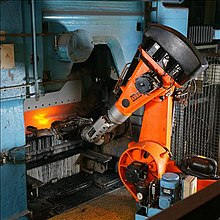
KUKA industrial robot operating in a foundry
Further information: Mobile manipulator
Robots need to manipulate objects; pick up, modify, destroy, or
otherwise have an effect. Thus the "hands" of a robot are often referred
to as
end effectors,
[31] while the "arm" is referred to as a
manipulator.
[32]
Most robot arms have replaceable effectors, each allowing them to
perform some small range of tasks. Some have a fixed manipulator which
cannot be replaced, while a few have one very general purpose
manipulator, for example a humanoid hand.
For the definitive guide to all forms of robot end-effectors, their design, and usage consult the book "Robot Grippers".
[33]
Mechanical grippers
One of the most common effectors is the gripper. In its simplest
manifestation it consists of just two fingers which can open and close
to pick up and let go of a range of small objects. Fingers can for
example be made of a chain with a metal wire run through it.
[34] Hands that resemble and work more like a human hand include the Shadow Hand, the Robonaut hand,
[35] ... Hands that are of a mid-level complexity include the Delft hand.
[36][37]
Mechanical grippers can come in various types, including friction and
encompassing jaws. Friction jaws use all the force of the gripper to
hold the object in place using friction. Encompassing jaws cradle the
object in place, using less friction.
Vacuum grippers
Vacuum grippers are very simple astrictive
[38] devices, but can hold very large loads provided the prehension surface is smooth enough to ensure suction.
Pick and place robots for electronic components and for large objects
like car windscreens, often use very simple vacuum grippers.
General purpose effectors
Some advanced robots are beginning to use fully humanoid hands, like the Shadow Hand, MANUS,
[39] and the Schunk hand.
[40] These are highly dexterous manipulators, with as many as 20 degrees of freedom and hundreds of tactile sensors.
[41]
Locomotion
Main articles: Robot locomotion and Mobile robot
Rolling robots

Segway in the Robot museum in Nagoya.
For simplicity most mobile robots have four wheels or a number of continuous tracks.
Some researchers have tried to create more complex wheeled robots with
only one or two wheels. These can have certain advantages such as
greater efficiency and reduced parts, as well as allowing a robot to
navigate in confined places that a four wheeled robot would not be able
to.
Two-wheeled balancing robots
Balancing robots generally use a gyroscope
to detect how much a robot is falling and then drive the wheels
proportionally in the opposite direction, to counterbalance the fall at
hundreds of times per second, based on the dynamics of an inverted pendulum.
[42] Many different balancing robots have been designed.
[43] While the Segway
is not commonly thought of as a robot, it can be thought of as a
component of a robot, when used as such Segway refer to them as RMP
(Robotic Mobility Platform). An example of this use has been as NASA's Robonaut that has been mounted on a Segway.
[44]
One-wheeled balancing robots
Main article: Self-balancing unicycle
A one-wheeled balancing robot is an extension of a two-wheeled
balancing robot so that it can move in any 2D direction using a round
ball as its only wheel. Several one-wheeled balancing robots have been
designed recently, such as Carnegie Mellon University's "Ballbot" that is the approximate height and width of a person, and Tohoku Gakuin University's "BallIP".
[45]
Because of the long, thin shape and ability to maneuver in tight
spaces, they have the potential to function better than other robots in
environments with people.
[46]
Spherical orb robots
Main article: Spherical robot
Several attempts have been made in robots that are completely inside a
spherical ball, either by spinning a weight inside the ball,
[47][48] or by rotating the outer shells of the sphere.
[49][50] These have also been referred to as an orb bot
[51] or a ball bot.
[52][53]
Six-wheeled robots
Using six wheels instead of four wheels can give better traction or grip in outdoor terrain such as on rocky dirt or grass.
Tracked robots

TALON military robots used by the United States Army
Tank tracks provide even more traction than a six-wheeled robot.
Tracked wheels behave as if they were made of hundreds of wheels,
therefore are very common for outdoor and military robots, where the
robot must drive on very rough terrain. However, they are difficult to
use indoors such as on carpets and smooth floors. Examples include
NASA's Urban Robot "Urbie".
[54]
Walking applied to robots
Walking is a difficult and dynamic problem to solve. Several robots
have been made which can walk reliably on two legs, however none have
yet been made which are as robust as a human. There has been much study
on human inspired walking, such as AMBER lab which was established in
2008 by the Mechanical Engineering Department at Texas A&M
University.
[55] Many other robots have been built that walk on more than two legs, due to these robots being significantly easier to construct.
[56][57]
Walking robots can be used for uneven terrains, which would provide
better mobility and energy efficiency than other locomotion methods.
Hybrids too have been proposed in movies such as I, Robot,
where they walk on 2 legs and switch to 4 (arms+legs) when going to a
sprint. Typically, robots on 2 legs can walk well on flat floors and can
occasionally walk up stairs. None can walk over rocky, uneven terrain. Some of the methods which have been tried are:
ZMP Technique
Main article: Zero Moment Point
The Zero Moment Point (ZMP) is the algorithm used by robots such as Honda's ASIMO. The robot's onboard computer tries to keep the total inertial forces (the combination of earth's gravity and the acceleration and deceleration of walking), exactly opposed by the floor reaction force (the force of the floor pushing back on the robot's foot). In this way, the two forces cancel out, leaving no moment (force causing the robot to rotate and fall over).
[58]
However, this is not exactly how a human walks, and the difference is
obvious to human observers, some of whom have pointed out that ASIMO
walks as if it needs the lavatory.
[59][60][61]
ASIMO's walking algorithm is not static, and some dynamic balancing is
used (see below). However, it still requires a smooth surface to walk
on.
Hopping
Several robots, built in the 1980s by Marc Raibert at the MIT
Leg Laboratory, successfully demonstrated very dynamic walking.
Initially, a robot with only one leg, and a very small foot, could stay
upright simply by hopping. The movement is the same as that of a person on a pogo stick. As the robot falls to one side, it would jump slightly in that direction, in order to catch itself.
[62] Soon, the algorithm was generalised to two and four legs. A bipedal robot was demonstrated running and even performing somersaults.
[63] A quadruped was also demonstrated which could trot, run, pace, and bound.
[64] For a full list of these robots, see the MIT Leg Lab Robots page.
Dynamic balancing (controlled falling)
A more advanced way for a robot to walk is by using a dynamic
balancing algorithm, which is potentially more robust than the Zero
Moment Point technique, as it constantly monitors the robot's motion,
and places the feet in order to maintain stability.
[65] This technique was recently demonstrated by Anybots' Dexter Robot,
[66] which is so stable, it can even jump.
[67] Another example is the TU Delft Flame.
Passive dynamics
Main article: Passive dynamics
Perhaps the most promising approach utilizes passive dynamics where the momentum of swinging limbs is used for greater efficiency. It has been shown that totally unpowered humanoid mechanisms can walk down a gentle slope, using only gravity
to propel themselves. Using this technique, a robot need only supply a
small amount of motor power to walk along a flat surface or a little
more to walk up a hill. This technique promises to make walking robots at least ten times more efficient than ZMP walkers, like ASIMO.
[68][69]
Other methods of locomotion
Flying
A modern passenger airliner is essentially a flying robot, with two humans to manage it. The autopilot can control the plane for each stage of the journey, including takeoff, normal flight, and even landing.
[70] Other flying robots are uninhabited, and are known as unmanned aerial vehicles
(UAVs). They can be smaller and lighter without a human pilot on board,
and fly into dangerous territory for military surveillance missions.
Some can even fire on targets under command. UAVs are also being
developed which can fire on targets automatically, without the need for a
command from a human. Other flying robots include cruise missiles, the Entomopter, and the Epson micro helicopter robot.
Robots such as the Air Penguin, Air Ray, and Air Jelly have
lighter-than-air bodies, propelled by paddles, and guided by sonar.
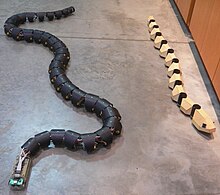
Two robot snakes. Left one has 64 motors (with 2 degrees of freedom per segment), the right one 10.
Snaking
Several snake
robots have been successfully developed. Mimicking the way real snakes
move, these robots can navigate very confined spaces, meaning they may
one day be used to search for people trapped in collapsed buildings.
[71] The Japanese ACM-R5 snake robot
[72] can even navigate both on land and in water.
[73]
Skating
A small number of skating
robots have been developed, one of which is a multi-mode walking and
skating device. It has four legs, with unpowered wheels, which can
either step or roll.
[74] Another robot, Plen, can use a miniature skateboard or rollerskates, and skate across a desktop.
[75]
Climbing
Several different approaches have been used to develop robots that
have the ability to climb vertical surfaces. One approach mimics the
movements of a human climber on a wall with protrusions; adjusting the center of mass and moving each limb in turn to gain leverage. An example of this is Capuchin,
[76] built by Stanford University, California. Another approach uses the specialized toe pad method of wall-climbing geckoes, which can run on smooth surfaces such as vertical glass. Examples of this approach include Wallbot
[77] and Stickybot.
[78]
China's "Technology Daily" November 15, 2008 reported New Concept
Aircraft (ZHUHAI) Co., Ltd. Dr. Li Hiu Yeung and his research group have
recently successfully developed the bionic gecko robot "Speedy
Freelander". According to Dr. Li introduction, this gecko robot can
rapidly climbing up and down in a variety of building walls, ground and
vertical wall fissure or walking upside down on the ceiling, it is able
to adapt on smooth glass, rough or sticky dust walls as well as the
various surface of metallic materials and also can automatically
identify obstacles, circumvent the bypass and flexible and realistic
movements. Its flexibility and speed are comparable to the natural
gecko. A third approach is to mimick the motion of a snake climbing a
pole
[citation needed].
Swimming (like a fish)
It is calculated that when swimming some fish can achieve a propulsive efficiency greater than 90%.
[79] Furthermore, they can accelerate and maneuver far better than any man-made boat or submarine,
and produce less noise and water disturbance. Therefore, many
researchers studying underwater robots would like to copy this type of
locomotion.
[80] Notable examples are the Essex University Computer Science Robotic Fish,
[81] and the Robot Tuna built by the Institute of Field Robotics, to analyze and mathematically model thunniform motion.
[82] The Aqua Penguin, designed and built by Festo of Germany, copies the streamlined shape and propulsion by front "flippers" of penguins. Festo have also built the Aqua Ray and Aqua Jelly, which emulate the locomotion of manta ray, and jellyfish, respectively.



